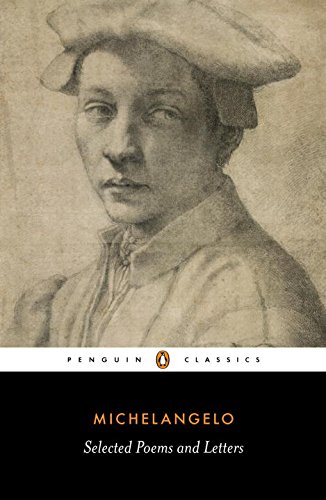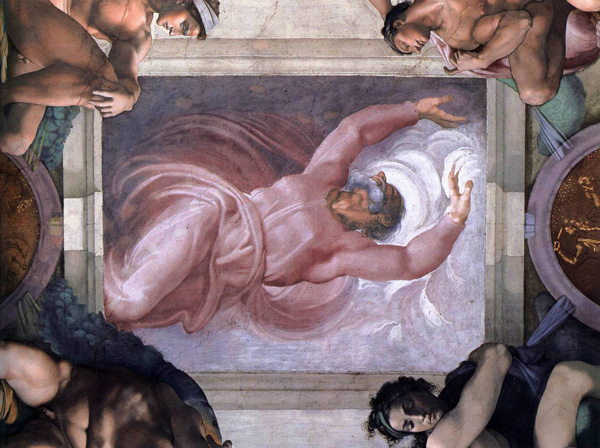----
Michelangelo on Struggle and Creative Integrity //
Brain Pickings "I do not know which is better, the ill that helps or the good that harms."
 Italian Renaissance sculptor, painter, poet, architect, and engineer Michelangelo (March 6, 1475–February 18, 1564) is celebrated as one of the greatest and most influential artists of all time. In 1505, thirty-year-old Michelangelo was commissioned to build a tomb for the newly elected Pope Julius II in Rome. It was an arduous process marred by constant interruption and interference by the pope, a bona fide micro-manager. Today, as scientists are finding that it takes our brains 23 minutes to recover from an interruption, Michelangelo's tenacity and his ability to carry out his creative vision despite the maddening meddling seems triply worthy of awe.
Italian Renaissance sculptor, painter, poet, architect, and engineer Michelangelo (March 6, 1475–February 18, 1564) is celebrated as one of the greatest and most influential artists of all time. In 1505, thirty-year-old Michelangelo was commissioned to build a tomb for the newly elected Pope Julius II in Rome. It was an arduous process marred by constant interruption and interference by the pope, a bona fide micro-manager. Today, as scientists are finding that it takes our brains 23 minutes to recover from an interruption, Michelangelo's tenacity and his ability to carry out his creative vision despite the maddening meddling seems triply worthy of awe.
Indeed, he knew value of undisturbed creative labor and protected it fiercely, unafraid to stand up to the most powerful man in Europe. Unable to bear the interruptions any longer and determined to do his work on his own terms, he left Rome and returned to Florence, where he could work on his sketches and sculptures for the project in peace. In one of the missives collected in Poems and Letters: Selections, with the 1550 Vasari Life (public library) — an invaluable glimpse of the inner workings of Michelangelo's genius, from his daily struggles to his most elemental creative credos — he writes to the pope's head architect, defending his departure:
If I stayed in Rome, my own tomb would be made before the pope's. And this was why I left so suddenly.
Now you write to me on the pope's behalf, so you can read the pope this: let His Holiness understand that I am more willing than ever to carry on with the work; and if he wants the tomb come what may, he shouldn't be bothered about where I work on it, provided that, at the end of the five years we agreed on, it is set up in St Peter's, wherever he likes; and that it is something beautiful, as I have promised it will be: for I'm sure that if it's completed, there will be nothing like it in the world.

Michelangelo makes an impassioned, even indignant, case for what we now call remote work, half a millennium before cars and commuter rail and Skype:
Now if His Holiness wants to go on with it, he should place the deposit for me here in Florence and I'll write to tell him where. And I have many marbles on order in Carrara which I shall have brought here along with those I have in Rome. Even if it meant a serious loss to me, I shouldn't mind so long as I could do the work here; and I would forward the finished pieces one by one so that His Holiness would enjoy them just as much as if I were working in Rome — or even more, because he would just see the finished pieces without having any other bother. For the money and for the work I shall pledge myself as His Holiness desires and give him whatever security he requires here in Florence. Whatever it is, I'll give him that security before all Florence. Enough.
Although the project was scheduled to last five years, Michelangelo labored at it for four decades and never completed the tomb to his satisfaction — no doubt in large part due to the pope's unrelenting meddling. But as is often the case in creative culture, a small side project assigned to him shortly after the original tomb commission ended up becoming Michelangelo's most timeless legacy and one of the greatest works of art ever created: the ceiling of the Sistine Chapel, on which he worked almost incessantly between 1508 and 1512. And as is also often the case in art, Michelangelo's compensation was a pittance compared to the magnitude of his enduring gift to humanity.
In a letter to his father penned in September of 1512, as the Sistine Chapel project was drawing to a close, he writes:
I must warn you that I don't have a penny and that I'm barefoot and naked, so to speak, and I can't get the balance owed to me until I've finished the work; and I suffer the worst of hardships and toil. So, when you have to put up with some hardship yourself, don't be distressed, and as long as you can help yourself with your own money.
A month later, he sends his father a most understated, matter-of-fact, even wistful report on what is substantially one of the greatest masterpieces in the history of art:
I have finished the chapel I was painting: the pope is very happy with it, but other things haven't turned out as well as I hoped. I blame the times, which are so unfavorable to our art… I don't have what I need in order to do what I want to do.
Later that month, he writes to his father again:
I live in penury and think nothing of life or honors, that is of the world; and I live with immense toil and a thousand cares. And I have been like this for about fifteen years, without an hour of joy… I'm ready to do the same again for as long as I live or as long as I can.
It should be noted that Michelangelo tended to dramatize his poverty — he was actually made quite a lot by the era's standards. The Pope agreed to pay him 3,000 ducats for the ceiling of the Sistine Chapel. Even though Michelangelo was to buy his own materials, which cost about 1,000 ducats, the remaining 2,000 was a substantial amount — historians equate it to about $52,000 in today's money. (For a comparative reference point, his contemporary Leonardo — who died with 600 ducats in the bank — kept a careful log of expenditures in his notebooks and often listed the prices of common commodities: 11 ducats for a haircut, 13 for a shirt, 20 for a pair of glasses, 1 for a salad.)
Still, in the relative context of his cultural contribution, Michelangelo was practically robbed — consider, for instance, the exorbitantly greater sums contemporary architects are paid to build, say, a World Cup stadium where a very different form of modern worship takes place.

Separation of Light from Darkness: Michelangelo's fresco of The First Day of Creation, located above the altar of the Sistine Chapel
In a supreme twist of irony, Pope Julius II died just a few months later and was succeeded by a pope from the Medici family, history's greatest patrons of the arts — and yet Michelangelo's most enduring and beautiful work was done under financial strain and creative limitation. One is reminded of Kierkegaard, who observed that "the more a person limits himself, the more resourceful he becomes." Indeed, despite his complaints, Michelangelo was unperturbed by practical constraints and was carried forward by the truth of his creative vision, an "agent of transcendent power." He captured this universal credo of creative geniuses with simple sincerity in another letter:
What counts is that I shall do what I promised, come what may, and with God's help, I shall create the finest work ever made in Italy.
To be able to do that, Michelangelo continued to defend his creative autonomy. In 1524, while still working on the tomb, he wrote directly to the Medici pope Clement VII. However piously and humbly worded, his letter is essentially a telling-off, insisting on freedom from interference and interruption in his creative process:
Since intermediaries often cause serious misunderstandings, I make bold to write directly to Your Holiness about the tombs here in San Lorenzo. I must say I do not know which is better, the ill that helps or the good that harms. Witless and unworthy I may be, but I am certain that if I had been allowed to carry on as I started, all the marbles for these works would be in Florence today, blocked out as I need them and costing much less than they have so far; and they would be of admirable quality like the others I brought here.
Now I see that it is set to be a long business and I do not know how it will go on. If, therefore, something happens that displeases Your Holiness, I beg pardon, for I do not feel that I can be guilty where I have no authority. And if Your Holiness wants me to achieve something, I beg that you should not set other men over me in my own art, but have faith in me and give me a free hand; then Your Holiness will see what I can do and what account of myself I shall render.
That power of the artist's free hand, and the resoluteness with which Michelangelo defended it all his life, remains his greatest legacy. Befittingly, he depicted God separating light from darkness with his hands on the ceiling of the Sistine Chapel — and what is the artist's role in human life if not to separate, with his free hand, light from darkness?
Michelangelo's Poems and Letters is a magnificent read in its totality. Complement it with the illustrated life of Leonardo, Picasso on not compromising in your art, Jane Austen on defending your creative vision against commercial pressures, and Calvin and Hobbes creator Bill Watterson on creative integrity.
Donating = Loving
Bringing you (ad-free) Brain Pickings takes hundreds of hours each month. If you find any joy and stimulation here, please consider becoming a Supporting Member with a recurring monthly donation of your choosing, between a cup of tea and a good dinner.
You can also become a one-time patron with a single donation in any amount.
 Brain Pickings has a free weekly newsletter. It comes out on Sundays and offers the week's best articles. Here's what to expect. Like? Sign up.
Brain Pickings has a free weekly newsletter. It comes out on Sundays and offers the week's best articles. Here's what to expect. Like? Sign up.
----
Shared via
my feedly reader 




